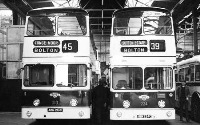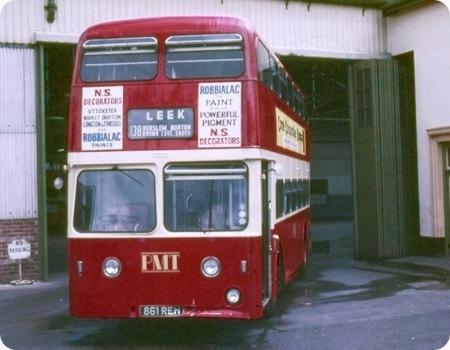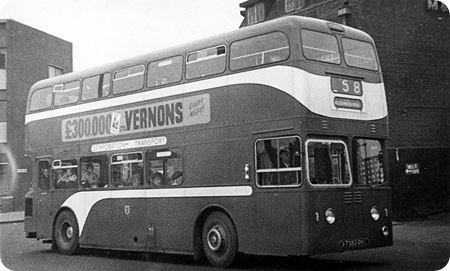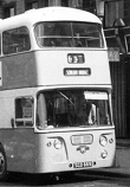
Photo by ‘unknown’ if you took this photo please go to the copyright page.
Bolton Corporation
1965
Leyland Atlantean PDR1/1
East Lancs H45/33F
Here we have two Bolton Corporation Leyland Atlanteans separated by only eleven registration and fleet number but they are both bodied by a different body builder. The one on the left was by East Lancs built in Blackburn Lancashire which is not many miles away from Bolton, the one on the right by MCW (Metro Cammell & Weymann) a Birmingham based body builder. All Atlanteans delivered to Bolton after this batch of 8 MCWs were all bodied by the local builder East Lancs,
Bus tickets issued by this operator can be viewed here.
The interesting thing about these Bolton vehicles is that the modern styling and colour scheme was the creation of the General Manager Ralph Bennett.
He subsequently went to Manchester as GM, where he created the Mancunian, the first bus to be specifically built with OPO in mind, which revolutionised both Manchester’s buses and, arguably set the trend for the whole country.
He then moved on to London Transport where he created the "Londoner" DM and DMS buses, though sadly LTE were far more timid than either Bolton or Manchester’s Transport Committees, and the result was pretty mediocre in comparison with his earlier work.
David Jones
Ralph Bennett was certainly responsible for the new Bolton livery, and as it first appeared on this style of Atlantean, he is generally credited with that as well. But in fact the design of the East Lancs body was a straight copy of the Metro-Cammell one apart from having slightly bigger windows, and the Metro-Cammell one had already appeared at Liverpool several months earlier, presenting a very different appearance in their livery.
I have often wondered who was really responsible for that Liverpool design. The managements of municipal fleets always had good relations with each other, and I wouldn’t be at all surprised at some sort of collaboration. I very much doubt that it was MCW.
Peter Williamson
28/08/11 – 12:19
I am wondering if Bolton Corporation Atlantean fleet number 192 is still around it was the first Atlantean bus to come on the road in 1963 and i drove it on the first day it came into service on the Bolton – Bury 52 Route we went from Thynne St in those days it had a automatic gearbox but could be driven manually through the gears number 4 slot on the selector box being the auto but was disconnected later and reverted to manual early problems were the fuel lift pump and in fact broke down on our last trip which was to Stopes Little Lever
Frank Ryle
28/08/11 – 15:50
Most interesting Frank – we had a batch of twenty new Atlanteans (406 – 425) at Leeds City Transport in 1970, and they had very smooth automatic gearboxes for that era – many systems at that time were diabolical and, in cases, downright dangerous but I really liked these twenty. Were yours the same in that if you selected 4th position at a standstill the bus would move away in second gear and then change up very smoothly. You had to select first gear when required in the normal "1" position on the "H".
Chris Youhill
29/08/11 – 07:56
Central Area and Green Country Area Routemaster buses (as opposed to Green Line coaches) were the same. They were fully automatic when 4 was selected and started in second from rest. They had full control of gears in semi-automatic mode using all the gates – including 1st.
Anyone who remembers original London operation might remember hill starts in 1st – but then shifting straight to 4 for automatic operation thereafter.
When I was driving RMs for Reading Mainline in the ’90s, we were told to drive in semi-auto mode rather than in fully automatic. [At that age some could cope with auto but others couldn’t.] The preserved RML that I drive still has fully auto capability but I prefer to drive it semi-auto to ensure a smooth drive – for which I am well known.
Interesting enough, the Alder Valley Bristol VRTs of the late 70s had a slightly different control – which I seem to recollect went over to some subsequent Leyland Olympians. They were fully automatic but always started in 1st – but the take up was harsh and brisk, meaning even the best of drivers could end up catapulting old ladies on to the back seat. They also had a very strange three gate control – Reverse, Forward and change down (after which you went back to Forward, ie auto).
David Oldfield
30/08/11 – 08:12
yes Chris it was the same as you say in auto mode pull away in second but the change wasn’t as smooth and a bit jerky as I said it was decided to disconnect the auto and just have manual on the subject of gearboxes in early sixties BOLTON still had some Crossleys and Leyland PD ones which had a crash box double de clutch and hope you matched up the revs otherwise you had no chance of changing up or down although they were fitted with a clutch stop which put a brake in the gearbox as they were at the end of their life it was hit and miss if they worked or not also a small number of front loading Daimlers with preselect boxes in first you could move the selector to second but it wouldn’t change until you pressed the clutch pedal which wasn’t a clutch pedal as such but a decompression pedal if you stabbed it quick the change was reasonable provided you match up the revs and road speed otherwise it would snatch fiercely
Frank Ryle
30/08/11 – 15:25
Interesting information again Frank and perhaps by 1970 that particular automatic system had been improved, because the twenty buses that I mentioned were impeccably behaved in auto or manual mode and admittedly they were new when I drove them. When with the famous independent operator Samuel Ledgard I drove many Leyland PD1s and PD2s. I passed my PSV test on a wonderful PD1, JUM 378 of 1946, and although I use the term "favourite" with care I think I must say that they are one of the most appealing and totally predictable models for me – the Ledgard fitters certainly kept the clutch stops in fine order even on buses twenty years old. The spring operated gear change on the Daimlers had to be treated with great respect if you wanted to avoid a trip to A & E with an ankle injury. Any wear on the selector linkages or failure to depress the gear change pedal positively and fully would result in the pedal flying out to twice the normal length with tremendous force – usually it could be restored by applying both feet to the pedal and pressing the shoulders against the cab rear window – Lord knows what the passengers must have thought !! Happy days, and the present generation of "fast men" think they have it hard with their super fully automatic buses and incredibly powerful engines – but no character or challenge – I wouldn’t have missed my early days for anything and I can still happily remember dozens, or many more, of individual vehicles and their peculiarities.
Chris Youhill
30/08/11 – 19:24
Chris, how I empathise with your sentiments on some of the present day crop of bus drivers. Power steering, auto gearboxes, powerful brakes, vehicle power to weight ratios that were undreamed of in our time…..! How would they cope with, say, a manual PD3 with synchro on the top two gears only. Mind you, driving a bus on the roads of today, having to cope with the stupid, suicidal, selfish lunacies of the cretinous Clarkson clone brigade that now infests our highways, is a far cry from those happier times of yore. I gave up bus driving finally five and a half years ago and wouldn’t want to go back to it except for classic vehicle jaunts. Also, as you say, these present day monsters of the bus fleets have about as much individual character as the wallpaper pattern in a Chinese restaurant. And as for some of these "modern" liveries, words fail me (and many will testify that this is an extreme rarity!).
I. too, remember (painfully) those Daimler preselectors. At Halifax, it was accepted practice not to warn the novice drivers about the endearing characteristics of the Daimler box. When it happened to me, the pedal came out half a mile (or so it seemed) giving me a hefty smack on the knee against the steering wheel in the process. I thought that I had broken the thing. The pedal was solid, and the bus remained obstinately in neutral. In sheer desperation, I swung round in the seat, and hoofed the pedal hard with both feet, finding, to my relief, that it went back to its proper place and behaved itself again. One could always pick out other sufferers with "Daimler knee" – they could be seen limping about the depot in a fair imitation of Laurence Olivier in Richard III.
Roger Cox
22/01/12 – 06:54
Frank 185 was the first Atlantean on the road for Bolton as I recall. And do you further remember an Atlantean was one of the stars of the film The Family Way starring Hayley Mills and Hywell Bennett
Tony
20/03/12 – 07:16
How I agree with Chris and Roger regarding modern vehicles and drivers, I always think with todays buses it is a case of point and steer and then hit the brakes almost as hard this combined with built in retarders and fully automatic gearboxes that nearly always change into low gear just as the bus stops make for an unpleasant ride. I know traffic conditions today demand some easing of the drivers lot but the semi-automatic systems of not so long ago were very easy to use and left the driver in control and able to give a smooth ride, however the easy use also meant easy abuse if a driver couldn’t be bothered but at least you had a choice. I too learnt to drive on a PD1 JK 9113 of Eastbourne Corporation in 1962 and I am glad that I was able to drive the characterful and interesting buses around at that time and not the mainly ugly soulless modern types at least I could give my passengers a comfortable ride at any time.
Diesel Dave
20/03/12 – 11:20
The seventies film Spring and Port Wine starring James Mason was also filmed in the Bolton area. Scenes on a bus were shot using the Leyland/Park Royal demonstrator KTD 551C. This bus later ran for Woods of Mirfield
Chris Hough
20/03/12 – 16:04
Right, Dave. You can often barely move in a "smooth modern bus" between stops because of the G-forces and sloping floors. You can only stand up and hang on! There is no need for stop/go driving like this: we can all do it, but not with passengers!
In the good old days you had long smooth braking- because that’s all they would do- with sound effects: although engine-braking using a Daimler preselector could explore the rev range a bit….
PS Anyone found a recording of a CVD6?
Joe
21/03/12 – 07:20
I’m waiting for someone to come up with that CVD6 recording as well. If there are no takers, is anyone planning a visit to the next Lincoln event? Could be a possibility to capture the sounds of the ex-Colchester Roberts vehicle – preferably with some hill starts!
Stephen Ford
21/03/12 – 07:22
There is of course another factor to take into account, buses now don’t have conductors, and at one time it was a easier to just drive the bus properly rather than suffer a constant ear bashing from a conductor who found it hard to walk around the bus unless it was stationary.
Ronnie Hoye
23/03/12 – 06:35
Ronnie has a very valid point regarding smooth driving and conductors as I started my career on the buses as a conductor and you very quickly learnt to pick out the best drivers to work with and those you hated your weeks of bumps and bruises with. When I started driving I tried not to do the things I hated as a conductor this I think kept me honest and I hope comfortable for the next 41 years. I find this site the most enjoyable on the internet as it lets me ramble on to my hearts content about the good old days to like minded soul, long may you prosper.
Diesel Dave
10/04/12 – 06:28
Totally agree with the comments on modern buses. They just don’t register with me at all and I have no interest in them, whereas proper buses have a character and individuality of their own. I never worked on the buses but travelled on them thousands of times as a child in the 60s and a teenager in the 70s when I used them for school. I lived in Radcliffe, and my favourites were Bury Corporations PD3s with Weymann bodies.
I remember them struggling up the very steep hill at the bottom of Stand Lane in Radcliffe on the way to Whitefield on the 65 with a full load and used to admire the way the drivers coped with these huge heavy looking buses.
The PD2s always seemed a bit lighter and easier to handle, don’t know if this was true. My interest started to go in the 80s after the ex municipal buses had gone. I liked the Selnec/GMT Standard Atlanteans/Fleetlines as well, but after those I sort of lost interest and after deregulation I completely gave up
David Pomfret
10/04/12 – 11:33
Re Smooth driving. As with David above, I have never had any involvement with buses except as a passenger when young so reading that a lot of favourite vehicles were misery to drive is very fascinating. From my first driving lesson I was always told to imagine that I had an egg in a dish stuck to the bonnet and that I had to keep it from rolling out. Does anyone remember that Jackie Stewart the racing driver ran a promotion with Ford Motor Co, in 1973/4 whereby drivers were challenged to drive a Ford Cortina Mark III with a tennis ball in a dish held to the bonnet only by a woollen blanket?
As regards bus driving, an old family friend, Lionel Coles who drove for Bristol Omnibus Company (often on the 88 to Radstock) was always very smooth but I also remember the gearbox crunches that so many K/KSW’s suffered in my school journey home on the number 1 to Cribbs Causeway when climbing the hill to Eagle Road, Brislington, Bristol. The fitters must have drained many ounces of iron filings!!
Richard Leaman
17/04/12 – 14:22
Southampton’s Atlanteans were of the East Lancs "Bolton" style, but without the fairing over the bustle. They used the Bolton style of livery, with the Manchester shade of red – Bill Lewis came to Southampton from Manchester. Strangely, he didn’t apply this lighter shade to the Arabs, Titans and Regents. When Blackpool started to buy Atlanteans, the Committee visited the East Lancs factory, where some were being built for Southampton, and adapted Southampton’s livery to have the extra stripe.
Pete Davies
 Vehicle reminder shot for this posting
Vehicle reminder shot for this posting
04/01/16 – 06:21
Any owner can do what they like with a vehicle. And having owned a North Western Bristol L5G I know many of the problems. Initially I was anxious to have it in original cream roof livery and did so but red roof spray paint colours would be just as legitimate. It spent 5 of its 13 years in service like that. The important thing us to have records that show changes.
CDB 206 is now in better condition then when I had it. Proper full length grab rails at entrance now. But the roof is all cream and no grey rectangle in the middle. Often forgotten.
Does it natter? Not now, but we should comment for the records. The generations that come after us will have no memory at all. We owe it to them to keep accurate records.
Bob Bracegirdle





